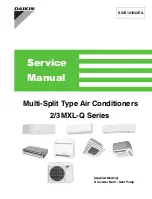
v
[6] Relocation and Repairs
[7] Additional Precautions
Relocation and Repairs
To reduce the risk of refrigerant leakage,
water leakage, injury, electric shock, and
fire, units should only be moved or repaired
by your dealer or qualified personnel.
To reduce the risk of wire shorting, electric
leak, electric shock, smoke, or fire, do not
perform maintenance work in the rain.
To reduce the risk of injury, electric shock,
and fire, properly reinstall all removed com-
ponents after completing repair work.
To reduce the risk of wire shorting, electric
shock, malfunctions, or fire, keep circuit
boards dust free, and do not touch them
with your hands or tools.
To reduce the risk of refrigerant and water
leakage, check the pipe supports and insu-
lation for damage during inspection or re-
pair, and replace or repair the ones that are
found to be deteriorated.
Additional Precautions
To avoid damage to the unit, use appropri-
ate tools to install, inspect, or repair the
unit.
To reduce the risk or malfunction, turn on
the power at least 12 hours before starting
operation, and leave the power turned on
throughout the operating season.
Recover all refrigerant in the units, and dis-
pose of it properly according to any applica-
ble laws and regulations.
Provide a maintenance access to allow for
the inspection of pipes above the ceiling or
the buried pipes.
Take appropriate measures against electri-
cal noise interference when installing the air
conditioners in hospitals or facilities with
radio communication capabilities. Inverter,
high-frequency medical, or wireless com-
munication equipment as well as power
generators may cause the air conditioning
system to malfunction. Air conditioning
system may also adversely affect the opera-
tion of these types of equipment by creating
electrical noise.
To reduce the risk of damage to the unit,
leave the valves on the unit closed until re-
frigerant charging is completed.
Place a wet towel on the refrigerant service
valve before brazing the pipes to keep its
temperature from rising above 120ºC and
damaging the surrounding equipment.
Direct the blazing torch flame away from the
adjacent cables and sheet metal to keep
them from being overheated and damaged.
Prepare tools for exclusive use with R410A.
Do not use the following tools if they have
been used with the conventional refrigerant
(R22): gauge manifold, charging hose, re-
frigerant leak detector, check valve, refrig-
erant charge spout, vacuum gauge, and
refrigerant recovery equipment. R410A
does not contain chloride, so leak detectors
for use with older types of refrigerants will
not detect an R410A leak. Infiltration of the
residual refrigerant, refrigerant oil, or water
on these tools may cause the refrigerant oil
in the new system to deteriorate or damage
the compressor.
To reduce the risk of the vacuum pump oil
backflowing into the refrigerant cycle and
causing the refrigerant oil to deteriorate,
use a vacuum pump with a check valve.
Have a set of tools for exclusive use with
R410A. Consult your nearest Mitsubishi
Electric Dealer.
Keep dust, dirt, and water off charging hose
and flare tool. Infiltration of dust, dirt, or wa-
ter into the refrigerant circuit may cause the
refrigerant oil to deteriorate or damage the
compressor.
Содержание PUHY-P1000
Страница 1: ......
Страница 11: ... 2 HWE14040 GB ...
Страница 27: ... 18 HWE14040 GB ...
Страница 40: ... 2 6 System Connection Example 31 HWE14040 GB 2 Restrictions ...
Страница 61: ... 52 HWE14040 GB ...
Страница 75: ... 66 HWE14040 GB ...
Страница 93: ... 84 HWE14040 GB ...
Страница 121: ... 112 HWE14040 GB ...
Страница 171: ... 6 11 Standard Operation Data Reference Data 162 HWE14040 GB ...
Страница 243: ... 7 9 Error Code Definitions and Solutions Codes 7000 7999 234 HWE14040 GB ...
Страница 295: ... 8 13 Troubleshooting Problems Using the LED Status Indicators on the Outdoor Unit 286 HWE14040 GB ...
Страница 297: ... 288 HWE14040 GB ...
Страница 334: ......







































